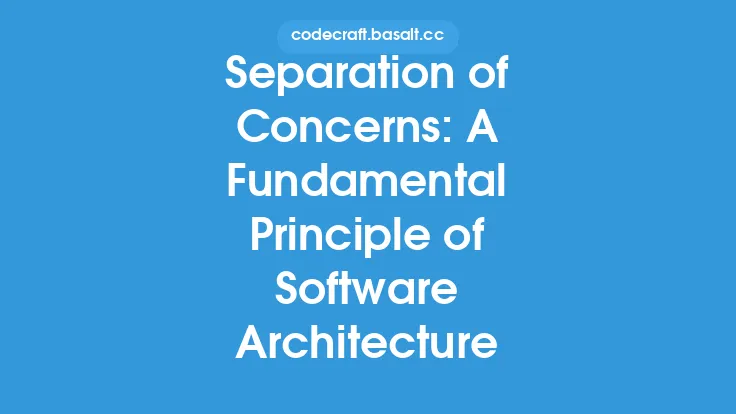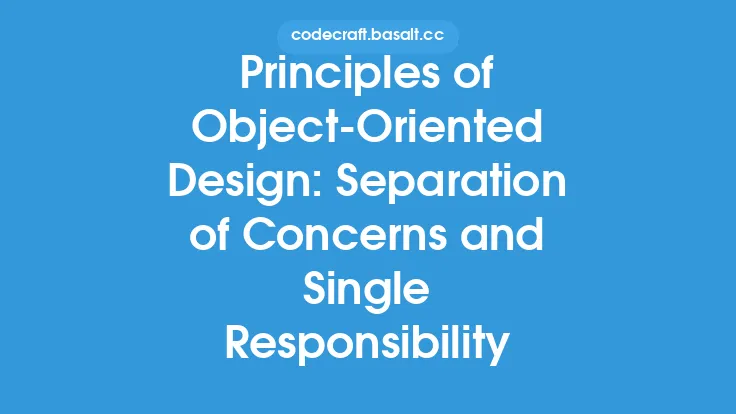Separation of concerns is a fundamental principle in software architecture that enables the creation of scalable and flexible software systems. This principle involves dividing a software system into smaller, independent components, each responsible for a specific concern or functionality. By separating concerns, developers can create systems that are easier to maintain, modify, and extend, as each component can be updated or replaced without affecting the entire system.
History and Evolution
The concept of separation of concerns has its roots in the early days of software development. In the 1970s, computer scientists such as Edsger Dijkstra and David Parnas introduced the idea of modular programming, which emphasized the importance of breaking down complex systems into smaller, independent modules. This approach allowed developers to focus on specific aspects of the system, reducing the complexity and improving the overall maintainability. Over time, the concept of separation of concerns has evolved to include various techniques and methodologies, such as aspect-oriented programming, model-driven architecture, and microservices architecture.
Key Benefits
Separation of concerns offers several benefits that make it an essential principle in software architecture. Some of the key benefits include:
- Improved maintainability: By separating concerns, developers can modify or update individual components without affecting the entire system.
- Increased flexibility: Separation of concerns enables developers to add new features or functionality without disrupting the existing system.
- Reduced complexity: Breaking down a complex system into smaller, independent components reduces the overall complexity, making it easier to understand and maintain.
- Enhanced scalability: Separation of concerns allows developers to scale individual components independently, improving the overall performance and efficiency of the system.
- Better reusability: Separated components can be reused in other parts of the system or even in different systems, reducing development time and costs.
Techniques and Methodologies
Several techniques and methodologies can be used to implement separation of concerns in software architecture. Some of the most common techniques include:
- Layered architecture: This approach involves dividing a system into layers, each responsible for a specific concern, such as presentation, business logic, or data access.
- Model-View-Controller (MVC) pattern: This pattern separates a system into three interconnected components: the model, which represents the data; the view, which represents the user interface; and the controller, which manages the interaction between the model and view.
- Aspect-oriented programming: This approach involves separating cross-cutting concerns, such as security or logging, from the main functionality of the system.
- Microservices architecture: This approach involves breaking down a system into smaller, independent services, each responsible for a specific concern or functionality.
Design Principles
To implement separation of concerns effectively, developers should follow several design principles. Some of the key principles include:
- Single responsibility principle: Each component should have a single, well-defined responsibility and should not be responsible for multiple, unrelated concerns.
- Separation of interface and implementation: The interface and implementation of a component should be separated, allowing for changes to the implementation without affecting the interface.
- Loose coupling: Components should be loosely coupled, meaning that changes to one component should not affect other components.
- High cohesion: Components should have high cohesion, meaning that they should be self-contained and independent.
Tools and Frameworks
Several tools and frameworks can be used to support separation of concerns in software architecture. Some of the most common tools and frameworks include:
- Dependency injection frameworks: These frameworks, such as Spring or Guice, enable developers to manage dependencies between components and separate concerns.
- Aspect-oriented programming frameworks: These frameworks, such as AspectJ or Spring AOP, enable developers to separate cross-cutting concerns from the main functionality of the system.
- Microservices frameworks: These frameworks, such as Netflix OSS or Apache Kafka, enable developers to build and manage microservices-based systems.
Challenges and Limitations
While separation of concerns offers several benefits, it also presents several challenges and limitations. Some of the key challenges and limitations include:
- Increased complexity: Separating concerns can introduce additional complexity, as developers need to manage multiple components and interfaces.
- Higher upfront costs: Implementing separation of concerns can require significant upfront investment, as developers need to design and implement multiple components and interfaces.
- Steep learning curve: Separation of concerns requires a deep understanding of software architecture and design principles, which can be a challenge for developers without prior experience.
Best Practices
To overcome the challenges and limitations of separation of concerns, developers should follow several best practices. Some of the key best practices include:
- Start with a clear understanding of the system's requirements: Developers should have a deep understanding of the system's requirements and functionality before implementing separation of concerns.
- Use established design principles and patterns: Developers should use established design principles and patterns, such as the single responsibility principle or the MVC pattern, to guide the implementation of separation of concerns.
- Keep components small and focused: Components should be small and focused, with a single, well-defined responsibility.
- Use tools and frameworks to support separation of concerns: Developers should use tools and frameworks, such as dependency injection frameworks or aspect-oriented programming frameworks, to support the implementation of separation of concerns.





